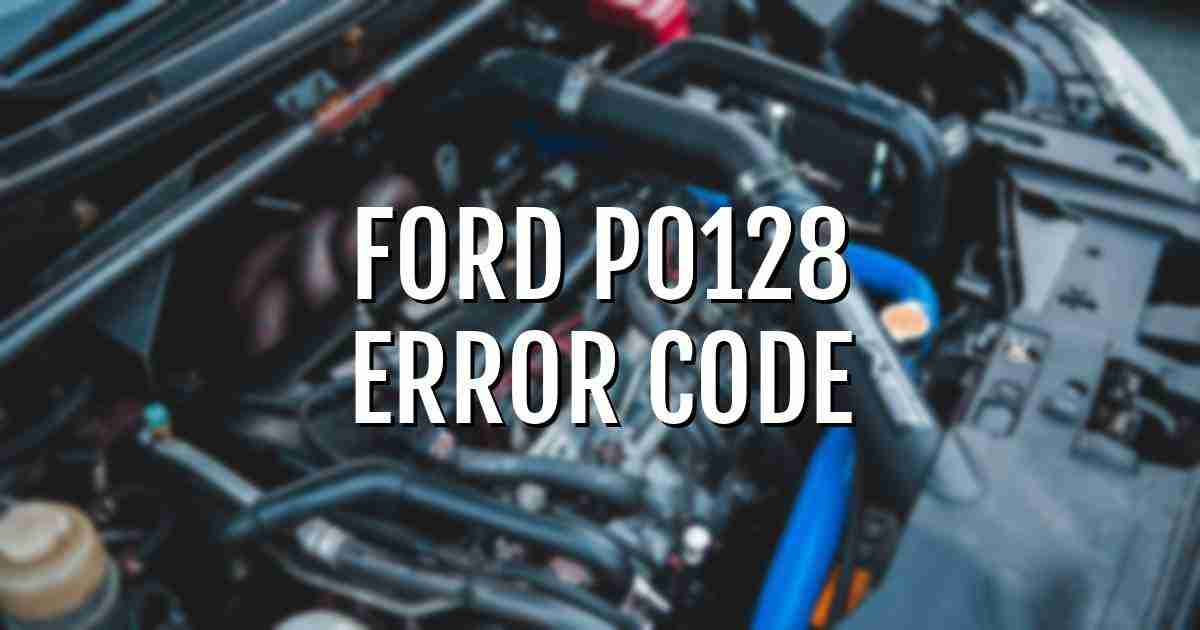The OBD code P0128 for Ford indicates a thermostat regulating engine temperature is not functioning properly.
This affects the engine coolant system.
Symptoms include the Engine Light being ON.
Causes may include a faulty thermostat, low coolant level, or a defective coolant temperature sensor.
While not an immediate emergency, it should be addressed promptly to prevent potential engine damage.
A possible fix involves inspecting and repairing the thermostat, coolant level, or sensor as needed.
| Repair Importance Level | 10.0 (Out of 10) |
| Estimated Repair Time | Approximately 1.0 hour |
| Repair Difficulty Level | 6.67 (Out of 10) |
Symptoms of the Ford p0128 OBD Code
The vehicle may exhibit a low coolant temperature condition according to Ford code P0128.
- Symptoms for Ford OBD code P0128: Engine Light ON (or Service Engine Soon Warning Light).
- Coolant temperature gauge reading lower or higher than normal.
- Decreased fuel economy.
- Delayed engine warmup time in cold weather.
Do you know you can clear most fault codes—but some could mean serious danger? Don’t take chances with your safety or your family’s safety. This budget-friendly car scanner makes it easy to clear fault codes in seconds while showing you exactly what’s wrong. Plug it in, connect to your Android or iOS phone, and instantly check live data. You’ll know if it’s a minor issue you can clear or something serious that needs attention—so you can drive safely and stress-free. (Today’s Deal)
Causes of the Ford p0128 OBD Code
P0128 in Ford vehicles typically indicates a thermostat regulating temperature below the specified threshold.
- P0128 can be caused by a leaking or stuck open thermostat.
- Low engine coolant level.
- Insufficient warm up time.
- A faulty engine coolant temperature sensor.
- An engine coolant temperature sensor harness that is open or shorted.
- A poor electrical connection in the engine coolant temperature sensor circuit.
Fixing Ford Error Code p0128 Step By Step
Address the P0128 code by checking the thermostat operation and coolant level for proper engine temperature regulation.
- To fix the Ford OBDII code P0128, start by reviewing the possible causes mentioned above and visually examining the corresponding wiring harness and connectors.
- Check for any damaged components and inspect the connector pins for signs of being broken, bent, pushed out, or corroded.
- Next, test the operation of the thermostat to ensure it is functioning correctly.
- If the thermostat is faulty, replace it with a new one.
- Clear the fault code from the vehicle’s computer using an OBDII scanner.
- Finally, test drive the vehicle to verify that the code does not return, indicating a successful repair.
Cost Of Fixing Ford p0128 Fault Code
The repair for Ford P0128 typically involves replacing the thermostat to address the cooling system issue.
The cost to diagnose and fix a Ford OBD code P0128 typically ranges from $75 to $150 per hour for labor rates.
With an estimated repair time of 1. 0 hour, the total cost can be around $75 to $150, depending on shop rates and the complexity of the issue.
That fault code is a turning point. If repair costs are climbing and your current loan feels like it’s holding you back, this is the time to plan ahead. The free Car Loan Payment Tracker helps you see how quickly you can pay off what’s left—and start preparing, with confidence, for your dream car.
Details of the Ford p0128 OBD Code
Ford code P0128 indicates a thermostat is stuck open or coolant temperature is below expected range.
OBD code P0128 for Ford vehicles indicates that the engine coolant temperature is below the thermostat regulating temperature.
This code is triggered by the Engine Control Module (ECM) when it detects that the coolant temperature does not reach the expected level within a specified time after starting the engine.
The P0128 code is related to the cooling system of the vehicle.
It typically points to an issue with the thermostat, coolant level, or a problem with the engine coolant temperature sensor.
When the ECM detects that the coolant temperature is not rising as expected, it illuminates the Check Engine Light and stores the P0128 trouble code in the vehicle’s computer memory.
Mechanic’s Tech Notes
Detailed information on diagnosing and fixing Ford code P0128 related to coolant thermostat issues.
To diagnose and fix OBDII code P0128 on a Ford, start by checking the thermostat operation and coolant level.
Use a scan tool to monitor coolant temperature sensor data while the engine warms up.
If the temperature doesn’t rise steadily or stays below the threshold, the thermostat or sensor may be faulty.
Check the thermostat for proper operation and replace if necessary.
Ensure the cooling system is functioning correctly.
If no issues are found, inspect the wiring harness and connectors for any damage or corrosion.
Use a voltmeter to test for proper voltage at the sensor.
Replace the sensor if voltage readings are incorrect.
FAQ
Common causes of OBD code P0128 in a Ford vehicle include a leaking or stuck open thermostat, low coolant level, faulty temperature sensor, or wiring issues.
Diagnose P0128 in Ford: Check thermostat, coolant level, warmup time, sensor, harness. Inspect wiring for damage, connector pins for issues. Fix as needed.
It is not safe to continue driving with OBD code P0128 in your Ford. Check for thermostat issues, low coolant, or faulty sensors immediately.

Wrap Up
If your Ford is displaying OBD code P0128 along with slowtowarmup engine or poor fuel economy, it may indicate a faulty thermostat, low coolant level, or a malfunctioning coolant temperature sensor.
These issues can lead to improper engine temperature regulation.
To address Ford OBD code P0128, start by checking the thermostat operation, coolant level, and the coolant temperature sensor.
Inspect the wiring harness and connectors for any damage or corrosion.
Replace any faulty components and ensure proper coolant levels for optimal engine performance.

